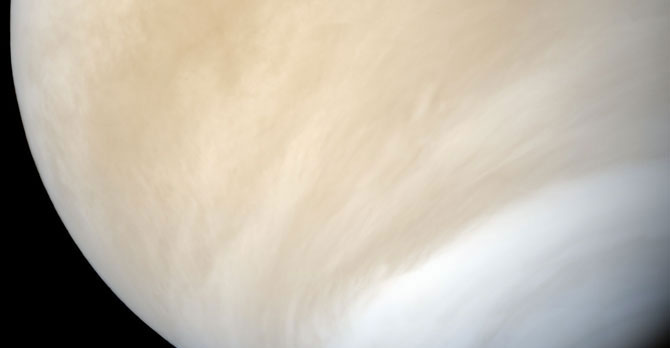.

Does Alien Life Thrive in Venus' Mysterious Clouds?
.
Personally, I’ve always thought that Venus gets a lot of bad press. Sure, it’s wrapped in clouds so strongly acidic that they dissolved the first few probes we tried to land there, and it has a surface temperature high enough to melt lead — but just above the cloud decks of Venus, you’ll find some of the most “Earth-like” conditions in our entire solar system.
This has prompted some astrobiologists to wonder if, contrary to popular belief, Venus may actually be a home to life of some kind. Perhaps we’ve been looking in the wrong place, and life on Venus is not on its surface but in its clouds.
In fact, roughly 50 to 65 kilometers (30-40 miles) above the surface of Venus, conditions are quite hospitable. Both temperature and pressure are similar to those on Earth. Water vapor and even scarce amounts of free oxygen can be found there. There isn’t much, but it’s there.
Astrobiological studies of Venus are, by nature, highly speculative. The notion sounds audacious but, from what we know of Earth life, it’s certainly not implausible. What’s more, there’s still very much about Earth’s twisted sister that we don’t understand.
We know that there are bacteria living in Earth’s clouds. They’re tolerant little beasts too, living in dry conditions, surviving high levels of ultraviolet light and low levels of oxygen. They’re even thought to help clouds to form, particularly in warmer climates.
On Venus, you might think that the potent acid which makes up the clouds may be a hindrance to any kind of Venusian microbes that may live there, but there are extremophile bacteria on Earth that live in similar conditions. One form of bacteria live in caves (the unappealingly named snottites), where they metabolise sulfur and create sulfuric acid. These bacteria create, and thrive in, acid as strong as what you might find in a car battery.
One scientist who’s given a lot of thought to life in unusual environments is Dirk Schulze-Makuch, currently at Washington State University. Something which he and his colleagues were interested by is the fact that the clouds of Venus seem to absorb more ultraviolet light than they should.
Being about 42 million kilometers (26 million miles) closer to the sun than Earth, the upper atmosphere of Venus is bombarded by enough ultraviolet to give lethal sunburn to anything without adequate protection. However, one idea is that molecular rings of sulfur could be giving something just that kind of protection.
Sulfur is plentiful in the atmosphere of Venus, and in its elemental form it likes to make molecules, each containing 8 sulfur atoms. Known as cyclo-octasulfur, these molecules absorb harmful UV and radiate it away at less harmful wavelengths. Could we be seeing sulfur sunblock? Perhaps, but then again perhaps not. Either way, whatever it is which is absorbing all that UV still hasn’t been conclusively identified.
Chemically, there’s definitely some mystery lurking in those beautiful clouds. Certain molecules are found there which shouldn’t be found together. Two in particular, sulfur dioxide (SO2) and hydrogen sulfide (H2S) shouldn’t be found together — when in the same place, they react with each other. The only conclusion is that, somehow, something on Venus must be creating them, otherwise there’d be none for us to see.
Another unexpected chemical in Venus’ atmosphere is known as carbonyl sulfide (OCS). On Earth, carbonyl sulfide is so difficult to create through inorganic processes that it’s been used as an “unambiguous indicator of biological activity“.
There’s one final piece in this bizarre acidic puzzle. The so-called “mode 3 cloud particles.” The clouds of Venus, much like the clouds on any other planet, are a menagerie of tiny droplets and ice crystals made up of the various chemicals found in the atmosphere. These cloud particles are normally fairly easy to identify, but the mode 3 particles are still a mystery.
They’re large, non-spherical, and they contain plenty of sulfuric acid. While it would be ridiculous to make any wild claims, it’s worth considering that those cloud particles are even the same size as bacteria — a notion that David Grinspoon, curator of astrobiology at the Denver Museum of Nature and Science, discussed in his book, Venus Revealed.
Of course, I’m not saying that there actually is life in the vitriolic Venusian clouds. There’s no way anyone could say that for certain, and there are still a lot of criticisms of the idea. The biggest sticking point being the lack of water — while there is some water in those clouds, it’s certainly scarce. All the same, there is something going on on that planet that Venus isn’t telling us. And it doesn’t seem like it’s going to give up its mysteries just yet.
Most people aren’t too keen on the idea that Earth’s “evil twin” may actually be a home to life, but you have to admit that all the evidence I’ve written about here gives some compelling food for thought. Venus is normally dismissed immediately when talking about alien life. Perhaps we shouldn’t give up on the big acid ball just yet.
Quelle: DNEWS
4981 Views

